Menus
- Vintage long distance bike
- Don’t forget the wrong circuit
- So far almost only with conventional gears
- V2 wakes up like a bull after a nightmare
- How can you drive fast laps with it??
- Deep stub, long tank, spartan seat
- 1,150 cubic is never wrong
- Mufflers are for an Aprilia RSV Mille
- Brake is less of a delight
- Turning in is almost playful
- There is a great uproar in the paddock
- Le Mans base simply good
- Motor extremely reliable and stable
- Better Guzzi than golf
- Zonko’s conclusion about the Horvath-Moto Guzzi Le Mans



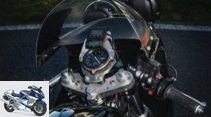
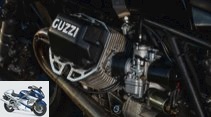
14th photos
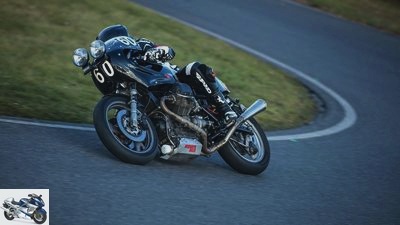
andreasriedmann.at
1/14
Horvath-Moto Guzzi Le Mans.
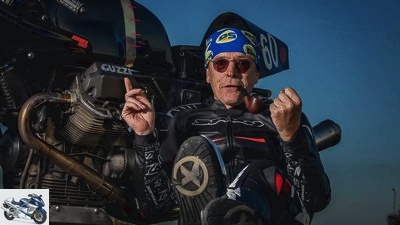
andreasriedmann.at
2/14
Zonko: "It is an uplifting feeling to be able to bring modern super sports cars with a 40-year-old machine whose chauffeurs still have potential for improvement."
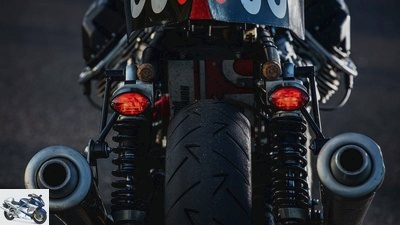
andreasriedmann.at
3/14
The Mivv pots were once intended for an Aprilia RSV Mille. Slightly modified, they give the Guzzi four more horsepower
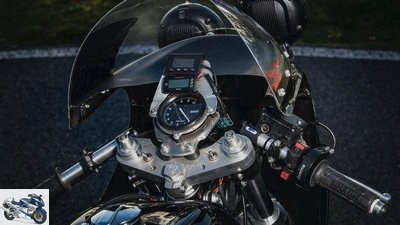
andreasriedmann.at
4/14
Old school racing. In the saddle, too, the prevailing image is rusticity, turning the throttle requires strength
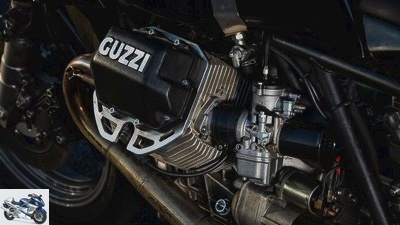
andreasriedmann.at
5/14
Master Horvath elicits a full 1150 cubic meters and 130 hp from the primitive V2. When the engine is running, it tosses it back and forth like crazy. Nevertheless, it takes the gas gently and develops something like smoothness from 4000 rpm
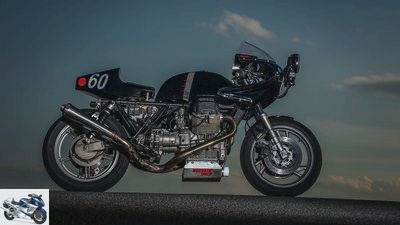
andreasriedmann.at
6/14
Horvath-Moto Guzzi Le Mans.
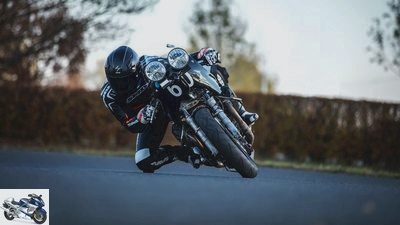
andreasriedmann.at
7/14
Horvath-Moto Guzzi Le Mans.
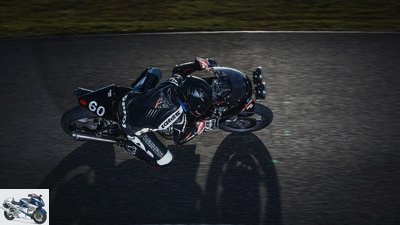
andreasriedmann.at
8/14
Horvath-Moto Guzzi Le Mans.
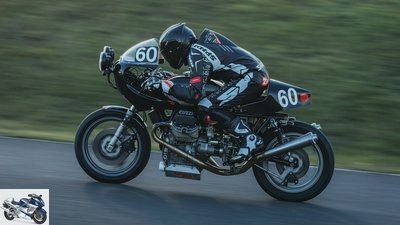
andreasriedmann.at
9/14
Security electronics? Never heard!

10/14
Team Horvath- Guzzi (Richie Rampula, Peter Horvath, Chris Zaiser) won the Italian Vintage Long Distance Championship in Misano 2016.
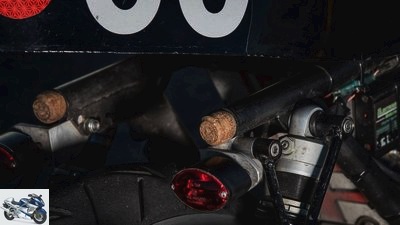
11/14
Horvath-Moto Guzzi Le Mans.
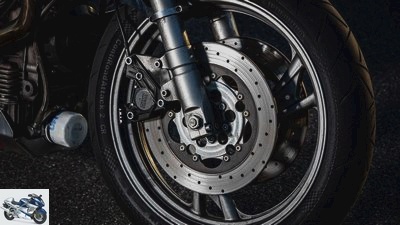
12/14
Horvath-Moto Guzzi Le Mans.

andreasriedmann.at
13/14
Horvath-Moto Guzzi Le Mans.
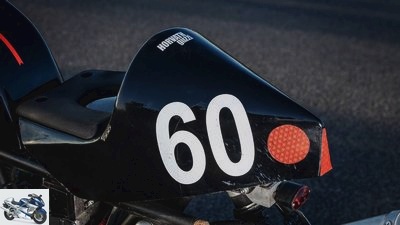
14/14
Horvath-Moto Guzzi Le Mans.
Zonko’s attack on the Horvath-Moto Guzzi Le Mans
Vintage long distance bike
Content of
The Guzzi-V2 delivers 130 hp, which evil tongues assign to the concrete mixers. The Horvath-Moto Guzzi Le Mans triumphed in the run for the Italian Vintage Endurance Championship. What can the insanely bad iron do?
Na, I’m not completely relaxed. I know the Pannoniaring very well and would also find the line in my sleep, but the Horvath-Moto Guzzi Le Mans is not a modern supersport machine, all of which are extremely user-friendly and safety-oriented these days, but a really nasty device, which on the one hand presumably reaches the limit early and on the other hand has no foolproof, saving electronics on board. To make matters worse, I have always loved Guzzis because of their strong charisma and unmistakable character, but that I would never have chosen a fat eagle from Mandello for a trackday.
Buy complete article
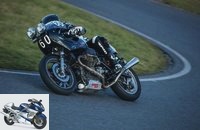
Zonko’s attack on the Horvath-Moto Guzzi Le Mans
Vintage long distance bike
V2 developed for use in the Fiat 500
No way! With all my love: For as long as I can remember, Guzzis have always been irons that had a high experience value in conventional road driving, but were completely inferior in racing. No power and no chassis – an unfavorable combination if you want to burn fast lap times into the asphalt. Nevertheless, I always hated derogatory comments, such as the 90-degree Guzzi V2 originally designed as a motor for a concrete mixer. Condescending is mostly bullshit, and especially in this case. Moto Guzzi won a total of 15 world and European championship titles in the 1940s and 1950s before retiring from racing in 1957 because the dramatic collapse of the motorcycle market had put the manufacturer from Mandello del Lario in dire financial straits. The racing department, thus deprived of its field of activity, then developed the Guzzi V2, which is still typical today, for use in the Fiat 500. Ultimately, Fiat took a different engine, but the engine is essentially still valid today. In the Horvath-Moto Guzzi Le Mans, it delivers 118 HP and 119 Nm on the rear wheel, certified to the test bench.
Don’t forget the wrong circuit
Before I get on, I have to reassure myself: “What about the narrow 18-inch tires? Do they have a grip and a limit area anyway, or do I get really excited when torque and power meet? “Peter Horvath, who has been building the strongest Guzzis and fastest on the racetrack for 40 years (no exaggeration), raises his eyebrows: “These are the CR from Continental. Very good tires. In the past, they didn’t build rubber that was worth sporting, but the CR is now the first choice for classic racing machines. We do an entire endurance run on one set of tires that lasts four hours. And you don’t have to warm it up for a long time. It already works in the third corner. You’ll see, that works really well. But don’t forget the wrong circuit! “
So far almost only with conventional gears
I always get hot ears when I hear the keyword “wrong gearshift”. It gets my pulse up and I get out of round. Is a trauma. It is logical that the ones on racing machines are up and then the other gears are pushed down, because you cannot put your foot under the gear lever when you are in a deep lean position when firing out. But since I’ve been socialized as a road driver and have driven 99 percent of my 700,000 kilometers on the iron with conventional gears, it’s easy for me to forget the unfamiliar gearshift pattern in the heat of the moment. It would of course be a disaster.
andreasriedmann.at
Horvath-Moto Guzzi Le Mans.
Apart from the fact that such a brutal passive over-revving leads to major engine damage because valves and pistons cannot avoid each other, a fall is also very likely. When you get full acceleration
and instead apply the full engine brake, you won’t stay seated. I have a trauma because years ago I was allowed to drive the Rossi’s Repsol MotoGP Honda in Jerez and in the middle of the second lap simply didn’t know whether the next gear was up or down.
V2 wakes up like a bull after a nightmare
Those were terrible seconds in which the growing panic made logical thinking impossible. I mean, as a journalist noodle, cutting off a MotoGP engine because you forgot the wrong gearshift is just not exactly what you want. Lifelong ostracism is not desirable – the Japanese are resentful. I nod. Fits. Ones above. Then Master Horvath presses the starter, gives the right dose of gas at the right moment, and the mighty Moto Guzzi Le Mans V2 wakes up like a bull after a nightmare. Brutal how it tears through the engine and how it shakes it back and forth impetuously in the frame. Mad!
How can you drive fast laps with it??
That must throw you off seamlessly in the radius! No matter. I have to go through that now. I send short bursts of throttle into the old Moto Guzzi Le Mans engine, which is now 1150 cc, think the harsh, muffled barking sound is great and am surprised to see how much power I need to turn the throttle. The two 40 mm Dellorto carburettors hanging on conventional cables are just different from electronically controlled throttle valves like ride-by-wire.
Deep stub, long tank, spartan seat
The seating position fits well. Old school racing. Deep stub, long tank, spartan seat, footrests far back and high. It is with the utmost benevolence that I register that the angry shaking engine develops something like smoothness from 4,000 rpm. The remarkably strong vibrations of the engine are always present up to the limiter at 8,700 rpm, but as soon as you have left the depths, it no longer shakes and shakes, and thus the fear that the V2 of the Horvath-Moto Guzzi Le Mans disappears The apex of the curve could cause unrest in the chassis.
1,150 cubic is never wrong
He does not. I’m really surprised how smoothly and fully the killer tuned old engine accelerates. It doesn’t explode. Not in the truest sense of the word anyway (that would be anything but ideal for long-distance races), and neither in terms of performance. Just over 5,000 rpm you have the feeling that the V2 is now throwing more coals into the fire, but overall it’s just a powerful course with a huge torque plateau. 1,150 cubic is never wrong. Compared to a standard Le Mans III from 1981, whose 850 engine did not serve much more than 60 hp regardless of the embellished factory specification, the Horvath-Moto Guzzi Le Mans is a tidal wave.
Mufflers are for an Aprilia RSV Mille
Of course, the master did not reveal the final subtleties of the tuning to me (“I’m just doing this for fun. And I don’t want another Guzzi to be as fast as mine”), but he showed the direction: lighter, finely balanced crankshaft , Carillo connecting rods, larger forged pistons, higher compression, head machining and a sharp, lower camshaft that was machined from solid. Horvath: “Nobody else has this camshaft.” But he did reveal one small detail: “The mufflers are from Mivv for an Aprilia RSV Mille. They were cheap to buy. I took out the inserts and made two special end caps out of aluminum. Has brought four horsepower. “
Brake is less of a delight
I think the power and the good manners of the engine in terms of responsiveness and power delivery are great, the brakes excite me less. Compared to a modern super sports car, the anchor can definitely be described as a drama. A lot of hand strength is necessary, but the bite remains toothless. But that is not because Master Horvath is a staunch supporter of the philosophy “If you brake, you lose”, but because of the regulations for European vintage long-distance championships. Only two-piston calipers may be used there. There is more freedom with the spring elements. Wilbers stereo legs are used at the rear, and a fully adjustable 41 fork from a Honda VTR 1000 at the front. In connection with the very good tubular space frame that Lino Tonti designed for Moto Guzzi in the early 1970s (first used in 1971 in the V7 Sport , built up to the turn of the millennium), the Horvath-Moto Guzzi Le Mans shows an impeccable stability even for today’s conditions, which promotes confidence and allows decent cornering speeds.
Turning in is almost playful
Wow, unbelievable how the old iron eats its way through the radii! Even turning is almost playful and does not require strong impulses on the stumps. I have to make small cuts in line corrections in an inclined position. The Horvath-Moto Guzzi Le Mans developed a certain stubbornness. Well, I understand, I’ll eat the R6 with the not-so-knowledgeable chauffeur just in the next corner entrance. It doesn’t matter that the anchor isn’t great if the chassis and geometry allow you to roll into the radius at high speed. Splendid!
There is a great uproar in the paddock
Whenever the old Moto Guzzi Le Mans raged on the track, super athletes and super bikers come to the Horvath transporter in the paddock and marvel at the old iron that marches so murderously. Regular driver Richie Rampula (former Kawa Cup winner) manages 2.10 times at the Pannoniaring, the new shooting star in the Horvath-Guzzi team, Chris Zaiser (multiple national champion, SSP and SBK World Championship pilot), even 2.06. Many amateur racers are prepared on the very latest equipment.
Le Mans base simply good
Peter Horvath is good at that: “Guzzis have always been undervalued. When we left all the Japanese, Ducatis and BMWs behind us at the first Superbike race in Austria with driver Manfred Schopper at the beginning of the 80s, no one could do it. But the Moto Guzzi Le Mans basis was simply good. The Japanese would have liked the framework. Sure, you had to find performance back then and the series fork was anything but race-oriented, but you could do a lot with the Guzzi. And when we compete in classic long-distance races today, we are always good for the podium and usually also for victory. I don’t have an Olympic thought. We drive to win and we have to be the fastest Guzzi. “
Motor extremely reliable and stable
The year before last, Horvath-Guzzi finished second overall in the Italian Vintage Endurance Championship, and in 2016 they won the open class at Misano, including the fastest race lap. This year the plan is to start – and win – in all of the championship races. I am a little surprised that the engine of the Horvath-Moto Guzzi Le Mans, which is inflated to 130 hp, can easily last four hours and that the original cardan, which is frighteningly thin from today’s perspective, does not capitulate. Can that stuff withstand the stress of racing? Horvath: “The engine is extremely reliable and stable. But cardan and gearbox can almost be seen as wearing parts. But that’s not a problem. Guzzi didn’t change the cardan until 2000. There are enough used parts. And I hoarded racing gears from back then with the long first two gears and straight teeth in good time. “
Better Guzzi than golf
Finally, I ask a burning question: “Peter, you are retired, you are only working on your own Guzzis, so you can no longer draw any business advantage from the complex and expensive racing. There will probably be fewer spectators at the classic races than at the Austrian championship, sponsors ditto. What drives you? ”Horvath:“ When my Moto Guzzi Le Mans is a super sports car at track days, I like it very much. And when we show the Italians in their own championship in Misano, Imola or Mugello that our Guzzi can all level and win the big trophy, I am extremely happy. For me, racing is a hobby that I’m passionate about. Many people may not understand that, but I think golf, for example, is an idiot sport. “
Zonko’s conclusion about the Horvath-Moto Guzzi Le Mans
When I think about the Horvath-Moto Guzzi Le Mans, I have to admit that I never really believed the legends about the incredibly powerful Moto Guzzi. As a journalist, I have driven a lot of Adler-Eisen from Mandello since the mid-1990s and have always loved them for their strong character and life of their own, but I never felt the slightest urge to use them on a racetrack. The Horvath-Guzzi, however, turned out to be a racing iron that allowed serious lap times. It is an uplifting feeling to be able to bring modern super sports cars with a 40-year-old machine whose chauffeurs still have potential for improvement. May Horvath, Rampula and Zaiser win the 2017 Italian Vintage Endurance Championship!
Related articles
-
Zonko’s attack on the Yamaha FZ1 Fazer in the test
andreasriedmann.at 11 pictures andreasriedmann.at 1/11 Yamaha FZ1 Fazer. andreasriedmann.at 2/11 Contemplative, relaxed and socially suitable …
-
Zonko’s attack on the Honda RC30 AMA superbike
andreasriedmann.at 16 photos andreasriedmann.at 1/16 Picture gallery: Honda RC30-AMA-Superbike. andreasriedmann.at 2/16 Zonko’s attack!…
-
Famous motorcycles: Moto Guzzi 850 Le Mans
Gori Famous motorcycles: Moto Guzzi 850 Le Mans When eagles still flew Eagle wings are majestically emblazoned in the Moto Guzzi logo. At the time of the…
-
Zonko’s attack on the Mayer-Kawasaki ZX-10R
Andreas Riedmann 17 pictures andreasriedmann.at 1/17 Zonko’s attack on the Mayer-Kawasaki ZX-10R. andreasriedmann.at 2/17 Sharp borderline scalpel: …
-
Zonko’s attack on the Kawasaki Ninja H2
andreasriedmann.at 15 pictures andreasriedmann.at 1/15 Even before the German S 1000 RR, the Japanese R1M and the Italian 1299 Panagale and RSV4 …
-
On the move with the BMW R 100 RS, Kawasaki Z 900 and Moto Guzzi 850 Le Mans
Rivas 39 photos Arturo Rivas 1/39 The old controversial question of what makes really fast has moved bikers for generations: high performance, good…
-
Zonko’s attack on the Ducati 1098 Fighter RR
andreasriedmann.at 11 photos andreasriedmann.at 1/11 Picture gallery: Ducati 1098 Fighter RR in Zonko’s attack. andreasriedmann.at 2/11 When I think…
-
Zonko’s attack on the MV Agusta F3 800 Ago
andreasriedmann.at 12 pictures andreasriedmann.at 1/12 On the way to Aunt Rosi with a worthy device: MV Agusta F3 800 Ago. Beautiful! Reason for …
-
On the move: BMW R 100 S, Honda CB 900 F Bol d’Or, Moto Guzzi Le Mans I.
fact On the move: big bikes from the 70s BMW R 100 S, Honda CB 900 F Bol d’Or, Moto Guzzi Le Mans I. Content of At the turn of the decade, MOTORRAD…
-
Comparison test Moto Guzzi Le Mans against V11 Sport
Comparative test Moto Guzzi Le Mans against V11 Sport This other kind While other brands are always looking for new concepts, a Guzzi always remains a…